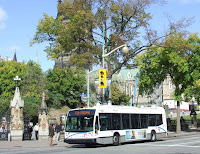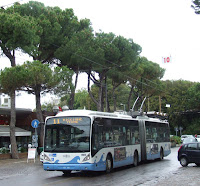Ottawa's urban rail system comprises just one single route, the O-train, a diesel-powered line which links 5 stations on a corridor to the west of the city centre. Unlike many of other cities I have visited, Ottawa has no underground railway, nor does it have a tram network. With the exception of the O-train, Ottawa's public transport is provided entirely by buses.
Services within Ottawa itself are provided by OCTranspo with a fleet of around 1,000 buses. A key element of the bus system is the Transitway, a system of segregated, bus-only roads radiating from the edge of the city centre into the suburbs.
Along the Transitways, buses serve purpose-built stations rather than bus stops. These are designed to allow buses to overtake when necessary.
The Transitways generally cross other roads using bridges or underpasses.
A core network of 6 routes operates over the Transitways. Articulated buses are the usual vehicles on the core Transitway services.

These core routes aren't confined to the Transitway itself. They use normal streets through the city centre area and also extend beyond the Transitway in outlying areas
Other than the core Transitway services, OCTranspo provide an extensive network of regular routes. Some of these connect with Transitway routes at key hubs, while a small number of regular routes operate directly into the city centre. Some regular routes are operated by articulated buses, others by standard single-deckers.




In some cases, regular routes use sections of the Transitway.
A flat fare is charged for travel on OCTranspo buses. The fare allows interchange for up to 90 minutes (105 minutes during the evenings and Sundays).
 During commuting times, the bus network is supplemented by a number of Express routes operating direct from the suburbs into the city centre in the morning and in the return direction in the afternoon. These generally use Transitways for part of the route. As well as providing direct links from areas not directly served by the core Transitway routes, the Express services also increase the capacity of Ottawa's bus network at peak times. A premium fare is charged for travel on Express buses.
During commuting times, the bus network is supplemented by a number of Express routes operating direct from the suburbs into the city centre in the morning and in the return direction in the afternoon. These generally use Transitways for part of the route. As well as providing direct links from areas not directly served by the core Transitway routes, the Express services also increase the capacity of Ottawa's bus network at peak times. A premium fare is charged for travel on Express buses.Express routes are operated by a mix of standard single-deckers and articulated buses.
OCTranspo aren't the only provider of bus services in Ottawa. The city centre is on the bank of the Ottawa River, which forms the border between the provinces of Ontario and Québec. Across the river, on the Québec side, is the city of Gatineau. Most bus services linking Gatineau with central Ottawa are provided by STO (Société de Transport de l'Outaouais) - the website default language is French but an English language version is also available.

The STO bus fleet is mainly standard single-deck, although articulated vehicles were introduced in 2012.
As with OCTranspo, the STO network comprises regular and express routes, with a higher fare being charged on the express (and "interzone") services. Transfer tickets allowing passengers to interchange at no further cost are available. Transfers issued by STO are accepted on OCTranspo services, and vice versa.
 Other than this sightseeing bus, I saw no double-deckers on Ottawa's streets. Would it be safe to conclude that there are none?
Other than this sightseeing bus, I saw no double-deckers on Ottawa's streets. Would it be safe to conclude that there are none? Actually, at the time of writing, there are 3 double-deckers operating in OCTranspo's fleet. They were introduced in 2008 as a trial. A further 75 such buses are due to enter service between October 2012 and April 2013. These will primarily displace articulated buses from commuter Express services. The articulated buses will be cascaded to other routes to replace standard single-deck buses. Interestingly, the double-deckers are deemed to have a higher capacity than the articulated vehicles, as the number of standing passengers permitted on the articulated vehicles is low.




























